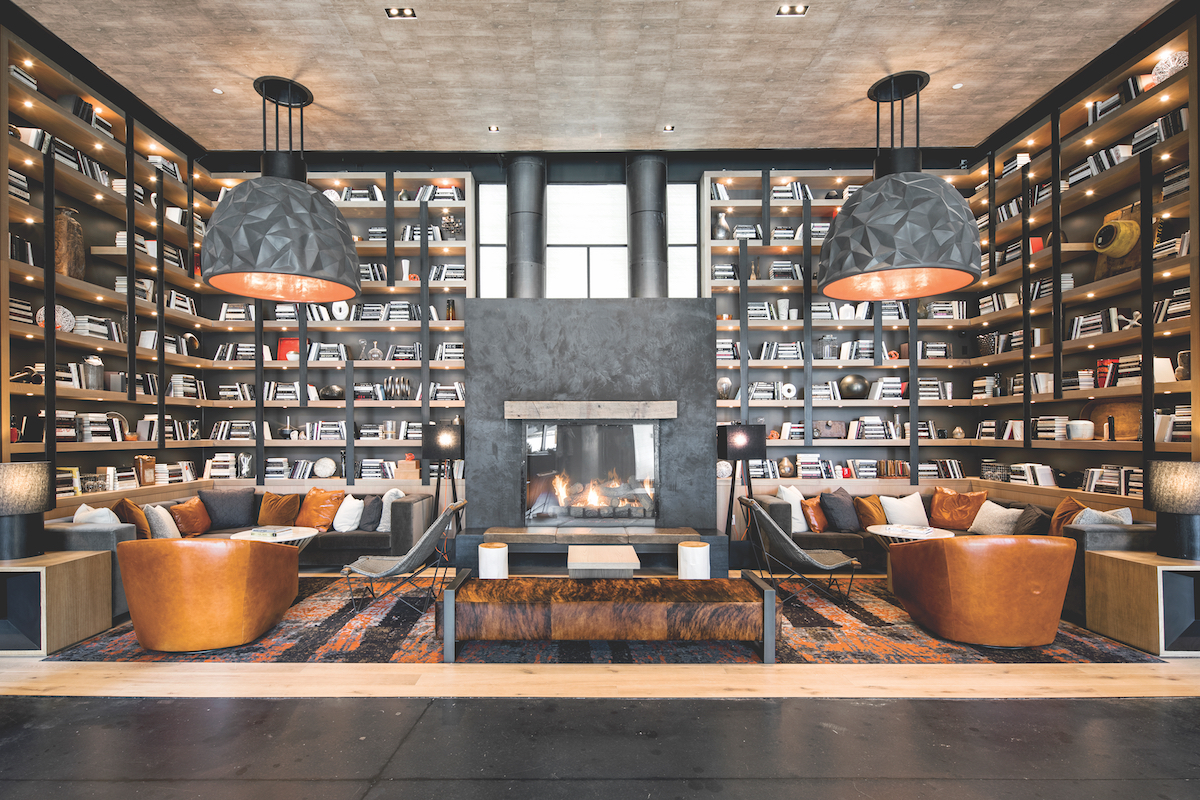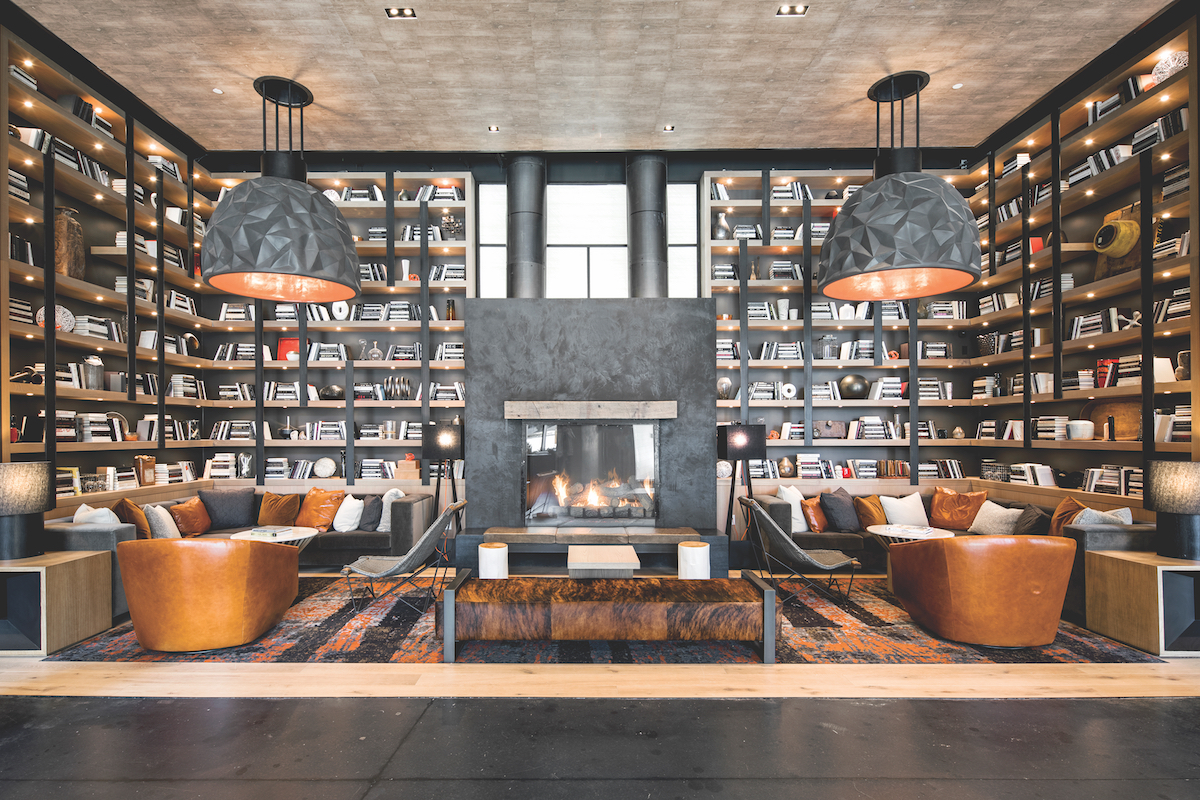1. ARTISTS’ HOUSING ADDS A SPLASH TO DOWNTOWN GLENDALE

Meta Housing Corporation (developer) and Studio One Eleven (designer) in May unveiled Ace 121, Glendale, Calif., an 80,000-sf affordable housing complex specifically designed to attract and support artists and their families. The 70-unit apartment complex has an 800-sf tenant-run art gallery (see photo at right, bottom) and a maker space with kilns, pottery wheels, and digital/media lab. Other amenities: a music room, performing arts room, community room, and courtyard/play area. Ace 121 was conceived to support Glendale’s Downtown Art and Entertainment District, which is anchored by the Alex Theatre, the Central Library, the Museum of Neon Art, and the Antaeus Theatre Company. The project is targeting LEED Gold certification. Photo: © Carlos Hernandez
2. CHILDREN’S ROOM BRIGHTENS ONE HUDSON YARDS

A Roto-designed children’s playroom with a custom climbing gym is just one feature at the Related Companies’ One Hudson Yards, 530 West 30th Street, along Manhattan’s High Line. The recently opened 33-story building, which is going for LEED Gold honors, was designed by Davis Brody Bond, with Executive Architect Ismael Leyva Architects; interiors by Andre Kikoski Architect. The 178 apartments range from one- to three-bedrooms, with a single four-bedroom penthouse. Rentals start at $5,095/month. Photo courtesy Related Companies
3. BOSTON’S ‘NEXT TECH CENTER’ GAINS 80 RENTAL UNITS

Shown here is the community/game room at Nova Residences, a new six-story, 68,000-sf apartment edifice in Brighton, Mass. A mix of 80 studios, lofts, and one- and two-bedroom living spaces, it is located in what some are calling Boston’s next IT enclave, near St. Elizabeth’s Medical Center. Rents range from $1,850 to $3,250; 10 units have been designated as affordable. The project team for owner LBC Boston: SN Consulting Group (architect); Allen & Major Associates (SE); Bohler Engineering (CE); Zade Associates (MEP); Wayne J. Griffin Electric; RBLA Design (landscape architect); NV5 (LEED consultant); and D. F. Pray General Contractors (CM).
4. O SAY CAN YOU SEE? IT’S ANTHEM HOUSE

Anthem House is a new $100 million lifestyle community on a three-acre abandoned industrial site in the Locust Point section of Baltimore. The 292 studio and one- and two-bedroom apartments have keyless entry, hardwood-style flooring, gourmet kitchens with quartz countertops, Energy Star appliances, porcelain-tiled bathrooms, and full-size washers and dryers. FX Studios programmed the fitness center. There’s 20,000 sf of retail and dining, 24/7 concierge service, collaborative workspaces, an acre of outdoor space, and a resort-style pool and sundeck with magnificent views of the harbor—boats and all that. The project team: KTGY Architecture + Planning (designer), Whitman, Requardt & Associates (CE); RD Jones & Associates (interiors); Mahan Rykiel Associates (landscape architecture); and Bozzuto Construction (GC). The Bozzuto Group, War Horse Cities, and Solstice Partners were the developers. Photo: Ray Cavicchio
5. RESORT-STYLE SENIOR LIVING IN SALT LAKE CITY

The Ridge, a $35 million, 138-unit “hospitality-driven senior living community” in Salt Lake City, was designed by studioSIX5 to inspire residents with the majesty of their surroundings—the foothills of the Wasatch Range—and stimulate their daily lives. In the memory care area, the team installed an oversized xylophone that residents can play. In the lobby, there’s a tile wall on which a projector plays short films during active hours. The designers incorporated USB and charging ports into the furniture so residents and their guests can use their electronic devices throughout the complex. Developer: AT Partners. Photo courtesy Alan Blakely
6. LUXE OPENS DOORS TO EMERGING AREA OF eastern PASADENA

The Luxe, a 128-unit mixed-use project developed by AMCAL, is located in eastern Pasadena, within walking distance of the Allen Avenue Gold Line Station. The design, by Withee Malcolm Architects, employs pale stucco and precast walls, deep arches, recessed voids and windows that allow shadows to define the character of the architecture. Floor plans range from studios to two-bedroom homes, which have wood-planked floors and 12-foot ceilings. Amenities include a tech-supported community room, resort-style pool, decks with mountain views, fitness center, and bicycle storage.
Related Stories
| Mar 22, 2011
Mayor Bloomberg unveils plans for New York City’s largest new affordable housing complex since the ’70s
Plans for Hunter’s Point South, the largest new affordable housing complex to be built in New York City since the 1970s, include new residences for 5,000 families, with more than 900 in this first phase. A development team consisting of Phipps Houses, Related Companies, and Monadnock Construction has been selected to build the residential portion of the first phase of the Queens waterfront complex, which includes two mixed-use buildings comprising more than 900 housing units and roughly 20,000 square feet of new retail space.
| Mar 17, 2011
Perkins Eastman launches The Green House prototype design package
Design and architecture firm Perkins Eastman is pleased to join The Green House project and NCB Capital Impact in announcing the launch of The Green House Prototype Design Package. The Prototype will help providers develop small home senior living communities with greater efficiency and cost savings—all to the standards of care developed by The Green House project.
| Mar 11, 2011
Renovation energizes retirement community in Massachusetts
The 12-year-old Edgewood Retirement Community in Andover, Mass., underwent a major 40,000-sf expansion and renovation that added 60 patient care beds in the long-term care unit, a new 17,000-sf, 40-bed cognitive impairment unit, and an 80-seat informal dining bistro.
| Mar 11, 2011
Mixed-income retirement community in Maryland based on holistic care
The Green House Residences at Stadium Place in Waverly, Md., is a five-story, 40,600-sf, mixed-income retirement community based on a holistic continuum of care concept developed by Dr. Bill Thomas. Each of the four residential floors houses a self-contained home for 12 residents that includes 12 bedrooms/baths organized around a common living/social area called the “hearth,” which includes a kitchen, living room with fireplace, and dining area.
| Mar 11, 2011
Texas A&M mixed-use community will focus on green living
HOK, Realty Appreciation, and Texas A&M University are working on the Urban Living Laboratory, a 1.2-million-sf mixed-use project owned by the university. The five-phase, live-work-play project will include offices, retail, multifamily apartments, and two hotels.
| Mar 1, 2011
How to make rentals more attractive as the American dream evolves, adapts
Roger K. Lewis, architect and professor emeritus of architecture at the University of Maryland, writes in the Washington Post about the rising market demand for rental housing and how Building Teams can make these properties a desirable choice for consumer, not just an economically prudent and necessary one.
| Feb 15, 2011
New Orleans' rebuilt public housing architecture gets mixed reviews
The architecture of New Orleans’ new public housing is awash with optimism about how urban-design will improve residents' lives—but the changes are based on the idealism of an earlier era that’s being erased and revised.
| Feb 11, 2011
Chicago high-rise mixes condos with classrooms for Art Institute students
The Legacy at Millennium Park is a 72-story, mixed-use complex that rises high above Chicago’s Michigan Avenue. The glass tower, designed by Solomon Cordwell Buenz, is mostly residential, but also includes 41,000 sf of classroom space for the School of the Art Institute of Chicago and another 7,400 sf of retail space. The building’s 355 one-, two-, three-, and four-bedroom condominiums range from 875 sf to 9,300 sf, and there are seven levels of parking. Sky patios on the 15th, 42nd, and 60th floors give owners outdoor access and views of Lake Michigan.
| Feb 11, 2011
Sustainable community center to serve Angelinos in need
Harbor Interfaith Services, a nonprofit serving the homeless and working poor in the Harbor Area and South Bay communities of Los Angeles, engaged Withee Malcolm Architects to design a new 15,000-sf family resource center. The architects, who are working pro bono for the initial phase, created a family-centered design that consolidates all programs into a single building. The new three-story space will house a resource center, food pantry, nursery and pre-school, and administrative offices, plus indoor and outdoor play spaces and underground parking. The building’s scale and setbacks will help it blend with its residential neighbors, while its low-flow fixtures, low-VOC and recycled materials, and energy-efficient mechanical equipment and appliances will help it earn LEED certification.
| Feb 11, 2011
Apartment complex caters to University of Minnesota students
Twin Cities firm Elness Swenson Graham Architects designed the new Stadium Village Flats, in the University of Minnesota’s East Bank Campus, with students in mind. The $30 million, six-story residential/retail complex will include 120 furnished apartments with fitness rooms and lounges on each floor. More than 5,000 sf of first-floor retail space and two levels of below-ground parking will complete the complex. Opus AE Group Inc., based in Minneapolis, will provide structural engineering services.















